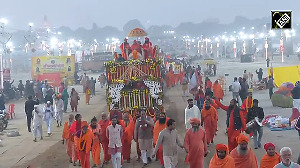The terror cycle on India was complete the day Mumbai was attacked. In terror circles, the ultimate is achieved when a fidayeen (suicide) attack is carried out. There seems to be no end to terror and it only seems to be getting worse by the day. While the Indian government steps up the pressure on Pakistan to hand over some men, the question is whether handing them over would put an end to the problem.
Intelligence Bureau officials told rediff.com that while diplomatic pressure is necessary, there is an immediate need to bust training camps in Pakistan. Let us now get into the depth of the matter and get a larger picture about these training camps.
Terrorist training:
IB records and confessions by various arrested terrorists go on to show that the main training camp is at Muzaffarabad in Pakistan-occupied Kashmir. Riazzuddin Nasir, a Lashkar-e-Tayiba terrorist arrested in Karnataka earlier this year, says the LeT has training camps in Karachi, Muzaffarbad and Afghanistan.
However, the LeT no longer uses its base in Afghanistan and focuses more on the bases at Muzaffarabad and Karachi. These are the two dedicated training camps for the banned outfit and other groups.
For the Mumbai attack, the men were all trained in an LeT facility at Karachi. Statements given by the arrested terrorist in the Mumbai case say they were trained for over a year at Karachi before they could launch this attack.
Who trains these men?
IB officials say the entire training module is inspired by the Al-Qaeda. The Al-Qaeda first picked up the entire programme from the US marines and started training their cadres accordingly.
It was in the year 1998 that the Lashkar picked up this method from the Al-Qaeda and started training their cadres in a similar fashion. However, the LeT has also adopted the Indian military commando training programme as it feels that it would be easier to fight Indian forces by adopting their own methods.
According to Nasir, the entire training is overseen by the ISI and it involves ex-army personnel. Kasab too, during his interrogation, said they were imparted training by ex-navy personnel.
Although an attack through the seas was something new for the country, the fact is that the LeT has been planning such attacks since the past four years. Nasir, in his confessions, said that since 2004, the LeT has been imparting maritime training.
Besides this, LeT operatives also say that after a successful operation, if any of these cadres manage to return to Pakistan, they are not used for any further operations but are asked to impart training to younger recruits.
He, however, adds that men from the LeT are more involved in planning, financing and organising an attack. The IB too says that the LeT does not involve itself too much with the training, but use the help of ex-army personnel for the same.
Why are younger boys chosen?
The IB says this is more a military tactic. When a youth is trained to undertake a fidayeen attack, he is expected to last longer during battle. For a fidayeen attack, boys under 30 are usually sent. A fidayeen training programme is extremely tough and involves extensive training.
They are required to sprint 100 meters in 12 to 15 seconds, run 10 kilometres during which only a half-an-hour break is allowed and marching 4 kilometres while carrying weight of 20 kg on them.
If a person is recruited and is unable to pass this test, they use him for a different role. Such persons are usually recruited into sleeper cells or are asked to take part in terror activities like carrying out blasts.
Indoctrination:
The ISI has ensured that cadres operating in Kashmir and those chosen for other attacks are not trained or recruited separately. For the ISI and Pakistan, Kashmir is an entirely different issue.
Those recruited for the Kashmir operation are trained extensively in guerrilla warfare. These men are also trained in fighting both on land and sea. However, the recruits for fidayeen attacks on cities undergo a slightly different pattern while training. They are trained on storming cities, running in between the cities while dodging security continuously for 3 kilometres. Apart from this, these men are also trained in undercover operations.
This helps these men in entering into a city and staying undercover before they launch the attack. Take the example of Nasir. He worked as cook and during this period he planned several operations, but was arrested before anything could materialise. Nasir says that since he loved to cook, he was asked to remain undercover as a cook.
On the difference in training for Kashmir terrorists and others, Nasir says those recruited for the Kashmir operation are trained only at Muzaffarabad in Pakistan-occupied Kashmir.
Recruitment:
The IB says the LeT has its agents across the world and the job of these men is pick boys and send them across to Pakistan for training.
Take the example of Shahid Bilal. He was an agent for the LeT and was working in a courier company. Young boys are identified by these agents and then the process begins. These agents first get friendly with the boys and when these agents realise that these boys can be motivated into taking up arms then they are sent to Pakistan for training and the indoctrination programme.
Dossiers and records show that the target usually is the extremely religious youth. Terror operatives feel that it is easier to brain wash these boys in the name of religion. Further, the recruitment process is also concentrated in areas where atrocities against Muslims are the most.
Before these boys are sent, a thorough background check is done and in the case of a recruit from India, these men ensure that the boy has no relatives in the Indian army.
Number of men waiting to strike:
Although it is difficult to give an exact figure as to how many men are ready to strike, IB sources say that there could be around 3000 men who are ready while an equal number undergoing training.
The IB says that recruitment is an ongoing process and everyday scores of youth are sent for training. The agency feels that it is extremely important to strike at such training camps apart from increasing diplomatic pressure in order to bring down the menace of terror.






 © 2025 Rediff.com -
© 2025 Rediff.com -